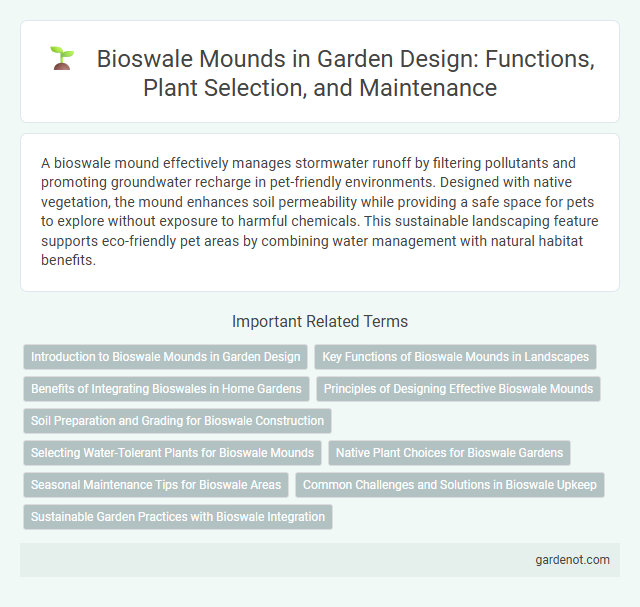A bioswale mound effectively manages stormwater runoff by filtering pollutants and promoting groundwater recharge in pet-friendly environments. Designed with native vegetation, the mound enhances soil permeability while providing a safe space for pets to explore without exposure to harmful chemicals. This sustainable landscaping feature supports eco-friendly pet areas by combining water management with natural habitat benefits.
Introduction to Bioswale Mounds in Garden Design
Bioswale mounds are strategically designed landscape features that enhance stormwater management by facilitating infiltration and filtration of runoff. They consist of contoured soil forms planted with native vegetation, promoting water absorption while reducing erosion and pollutant loads. Incorporating bioswale mounds in garden design supports sustainable water cycle management and improves urban green infrastructure.
Key Functions of Bioswale Mounds in Landscapes
Bioswale mounds enhance stormwater management by promoting infiltration and filtration of runoff, reducing pollutant loads in urban landscapes. These engineered earthforms support native vegetation growth, stabilizing soil and preventing erosion while improving habitat diversity. By integrating bioswale mounds into green infrastructure, urban areas benefit from improved water quality, flood mitigation, and increased ecological resilience.
Benefits of Integrating Bioswales in Home Gardens
Bioswale mounds in home gardens enhance stormwater management by filtering pollutants and reducing runoff volume, promoting healthier soil and plant growth. They improve groundwater recharge while preventing erosion, creating a sustainable landscape feature that supports local biodiversity. Integrating bioswales increases property value by combining ecological benefits with aesthetically pleasing garden design.
Principles of Designing Effective Bioswale Mounds
Bioswale mounds are designed to enhance stormwater management by promoting infiltration, filtration, and pollutant removal through strategic soil composition and vegetation selection. Effective bioswale mound design incorporates slope gradients that maximize water retention while preventing erosion, alongside deep, well-draining soils that support native plant roots for improved pollutant uptake. Integrating elongated, shallow basins with seasonal wetness mimics natural hydrology, optimizing nutrient cycling and stormwater peak flow reduction.
Soil Preparation and Grading for Bioswale Construction
Soil preparation and grading are critical steps in bioswale mound construction to ensure optimal water infiltration and pollutant filtration. The soil must be tested for permeability and amended with organic matter to enhance drainage and microbial activity, typically aiming for a loam texture with an infiltration rate of 0.3 to 1.0 inches per hour. Proper grading involves creating a gentle slope of 1-3% toward the swale center to direct stormwater flow while preventing erosion and pooling, facilitating effective runoff management and groundwater recharge.
Selecting Water-Tolerant Plants for Bioswale Mounds
Selecting water-tolerant plants for bioswale mounds enhances stormwater management by improving soil infiltration and reducing erosion. Species such as pickerelweed, soft rush, and blue flag iris thrive in fluctuating moisture conditions, supporting pollutant filtration and habitat diversity. Incorporating native wetland plants strengthens the bioswale's resilience and promotes long-term ecological benefits.
Native Plant Choices for Bioswale Gardens
Native plant choices for bioswale gardens include species such as switchgrass (Panicum virgatum), blue flag iris (Iris versicolor), and buttonbush (Cephalanthus occidentalis), which are well-adapted to wet and variable moisture conditions. These plants promote soil stabilization, enhance water filtration, and provide habitat for local wildlife. Selecting native species ensures resilience, reduces maintenance needs, and supports the ecological function of the bioswale mound.
Seasonal Maintenance Tips for Bioswale Areas
Bioswale mound maintenance requires seasonal attention to ensure optimal water filtration and plant health. In spring, remove accumulated debris and mulch to enhance soil aeration and promote native plant growth, while summer demands regular irrigation monitoring to prevent drought stress. Fall maintenance includes pruning dead vegetation and replenishing mulch to protect roots during winter months and maintain effective stormwater management.
Common Challenges and Solutions in Bioswale Upkeep
Bioswale mounds often face challenges such as soil compaction, invasive plant species, and erosion, which can impede water infiltration and reduce pollutant removal efficiency. Regular maintenance includes soil aeration to prevent compaction, selective planting to control invasive species, and installing erosion control measures like coir logs or native vegetation mats. Employing adaptive management practices tailored to site-specific conditions enhances the long-term performance and ecological benefits of bioswale mounds.
Sustainable Garden Practices with Bioswale Integration
Bioswale mounds enhance stormwater management by filtering pollutants through native vegetation and engineered soil layers, promoting ecological balance in sustainable garden practices. Incorporating bioswale mounds reduces runoff, improves groundwater recharge, and supports biodiversity with minimal maintenance. These green infrastructure elements align with eco-friendly landscaping by integrating natural water purification and erosion control techniques.
Bioswale mound Infographic

 gardenot.com
gardenot.com